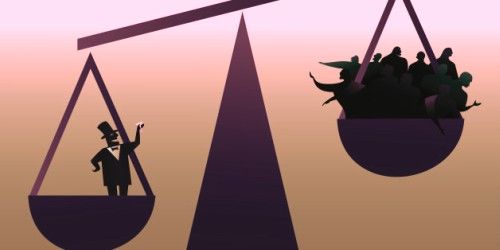
On Monday, Donald Trump unveiled his economic plan. It contained no actual numbers, so it wasn’t so much a plan as a theory. He sprinkled his comments with jabs at Hillary Clinton which could be, and were, fact checked, and Trump was shown to be dishonest once again. But the big lie in his speech was the theory he was touting, and that went unchallenged. The theory was the one that has been the mantra of establishment Republicans since Ronald Reagan: that massive tax cuts for wealthy individuals and corporations create jobs. In fact, the experiment has been tried, and it failed miserably. We don’t have to refute this with more theory when we have actual evidence. With just a little thought, we can find the fatal flaw in this theory. And it is also fair to talk about unintended consequences.
The United States had eight years of huge tax cuts of the sort Trump wants when George W Bush was president, and they gave us the weakest economic recovery in American history. The stimulus that was supposed to follow from this never happened, so we also saw a vast increase in the federal deficit. Pundits on the right will sometimes point out that we can’t know what the deficit might have looked like if we had not also been at war, but Trump gives me no confidence in that regard. Job growth was anemic, which made the 2007-2008 collapse far more painful than it needed to be. To understand why, you need to realize that trickle economics assumes that companies do not hire because they can not afford to. Why else would tax cuts stimulate the economy? But this assumption makes no sense. We have seen companies post record profits and sit on hordes of cash, but where are the jobs? And what happens to the money, if it does not prod hiring? One thing that happens is an increase in mergers and corporate takeovers. These actually cost the economy jobs.
Another is an increase in speculative investing. This is what wealthy individuals do with their tax cuts when they are supposed to be creating jobs. The Bush cuts created a new, lower tax rate for capital gains. Before, capital gains were taxed at the same rate as regular income, but Bush created a new rate that was about half the rate for earned income. A capital gain is the profit you make when you sell an investment for more than you bought it for. So now, when you calculated the risk of an investment, you could figure in the reduced tax rate. The new capital gains rate meant that it now made more sense than before to buy oil and gas futures as investments. This has meant that everyone pays a price at the pump that is inflated by the purchases of speculators. But the capital gains tax cut also made junk mortgage investments more attractive, thereby making the 2008 financial crisis worse. Trump, in his speech, also targeted what he called excessive regulations, so he would restore the conditions that made the 2008 crisis so serious. In particular, he made his billions in real estate, so he can be expected to work hard to remove any and all regulations on the real estate industry. Liar loans and other abuses in the mortgage industry that led to the financial crisis are all good for Trump’s business.
It is only fair to ask what does create jobs. Before Ronald Reagan sold the nation trickle down religion, it was widely understood that the real reason companies hire is that they expect to sell more stuff. That means good marketing and good new products, but it also requires a large number of consumers with spendable cash. This is why, in actual case histories, minimum wage increases generally lead to increases in hiring. So do boosts to programs like Food Stamps and Social Security. In theory, Universal Health Care in the United States would cost jobs in the insurance industry, but those losses would be more than offset by increases in consumer spending. Companies would also see a sharp reduction in their labor costs, since they would no longer have to provide medical benefits. Donald Trump wants to take this country in the opposite direction, and we have seen before where that would take us.
No comments:
Post a Comment